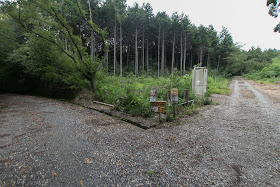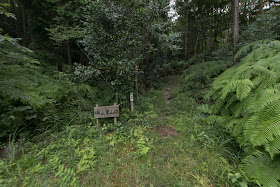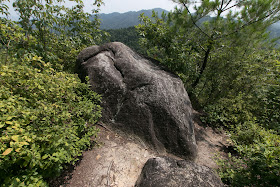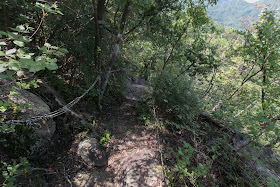Kozutsumi Shiroyama Castle
-History of warlord next to capital (1) independence from authority-
Overview
Name: Kozutsumi Shiroyama castle (Kozutsumi Shiroyama-jo)
Alias:
Place: Oshinohara Yasu city, Shiga
Location: 35.06532416044841, 136.0547926916612
Type: Mountain Castle
Built: 15th century?
Remnants: Stone walls, clay walls and dry moats
Title:
Kozutsumi Shiroyama castle (小堤城山城) is located over Shiroyama mountain, one of about 180 meter height from hillside which is the end of the ridge prolongs from Kagami-yama mountain in the south part of Yasu city. Castle side is also the end of hilly area between Yasu-gawa river and Hino-gawa river, which are two large rivers flows into eastern coast of Lake Biwako.
Currently castle site is at inland area, but before land reclamation marsh area spreads from the lake to just before the mountain, and only narrow flat area before the castle where Shinkansen-train, Tokaido Honsen-line and Route 8 run was accessible area. In that mean it is an important point to control the communication from Kyoto area to the east coast area of Lake Biwako.
Castle site is also a control point of Yasu-gawa river, which is the entrance into Koka area from coast side area of Lake Biwako. Only considering geographic condition Mikami-yama mountain, a beautiful corned shaped mountain like small Mt. Fuji is more suitable, but because of its too much height and usage as the body of the shrine did not allow using it as a castle thus Shiroyama mountain might be used.
Precise year is unknown but Kozutsumi Shiroyama castle might be built under local lord Nagahara clan in 15th century. The origin of Nagahara clan is also unknown but it might be originally the retainer of Mabuchi clan, which was the deputy governor of Rokkaku clan that was the governor of Omi province (Shiga prefecture) and held Yasu area and Gamo area.
During Muromachi era, Nagahara clan grew from economic activity at the coast of Lake Biwako, then became an independent local lord and directly served to Rokkaku clan. They had their residence at Nagahara castle, a flat square one at 2 kilometer northwest from castle site which was later used as the lodge of Shogun of Edo Shogunate, and built Kozutsumi Shiroyama castle for escape fortress in case of emergency.
Rokkaku clan was a branch family of Sasaki clan belonged to Uda-Genji family, which was originally a descendant of Emperor Uda (867-931) which moved to Omi province and became local samurai. Having the same surname, Sasaki clan served to Yoritomo Minamoto (1147-1199), the founder of Kamakura Shogunate, and activated at battles.
As a reward Sasaki clan achieved Omi province, and placed their branch families such as Kyogoku clan, Rokkaku clan, Takashima clan and Ohara clan around Lake Biwako. Later main family of Sasaki clan fell after the battle of Jokyu in 1221, and Rokkaku clan became the main family of Sasaki clan.
Rokkaku clan served as the governor of Omi province under Kamakura Shogunate. But at the fall of Kamakura Shogunate, Doyo Sasaki (1296-1373), the leader of Kyogoku clan who was known Basara (flashy) lord, contributed to the establishment of Muromachi Shogunate and became upper position of Rokkaku clan.
Kyogoku clan held their original territory at north east coast of Lake Biwako, and also managed Izumo province and Oki province (Shimane prefecture) and Hida province (northeast part of Gifu prefecture). Contrary to this, Rokkaku clan was nominally the governor of Omi province but only held southeast coast of Lake Biwako.
Due to the internal conflict and external conflict to Kyogoku clan or Hieizan Enryakuji temple, the power of Rokkaku clan in the former half of Muromachi era was weak. Deputy governor Iba clan exercised its power in the clan, and leaders of Rokkaku clan died in such conflicts.
However, during the battle of Onin continued from 1467 to 1478 at capital Kyoto city, Kyogoku clan belonged to the East army at the battle lost its leader and entered severe internal conflict. Utilizing this opportunity, Takayori Rokkaku (?-1520), the leader of Rokkaku clan, belonged the West army and fought with Kyogoku clan.
Being supported by surrounding governors such as Shiba clan of Owari province (west half of Aichi prefecture) or Toki clan of Mino province (Gifu prefecture), Takayori broke the main family of Kyogoku clan and seized southeast coast of Lake Biwako again. The battle of Onin ceased under the supremacy of the East army, thus Takayori turned to the East army and was appointed as the governor of Omi province.
As the territory of Nagahara clan was at the middle of the territory of Rokkaku clan and Kyoto city, Nagahara clan activated at the communication with the West army at Kyoto city, and also worked as a vanguard toward the East army stayed at the capital. Kozutsumi Shiroyama castle might be expanded as the forefront fort of Rokkaku clan against Kyoto city.
Kozutsumi Shiroyama castle consists of hilltop area, saddle area and northwest slope area. Hilltop area includes central area which is a rectangular one of 30 meter long and 15 meter wide, and several areas spreads along the ridge toward northwest over 150 meter long. Slope of each area is partially decorated by low height stone walls.
Saddle area spreads over the saddle part toward next small peak like “H” letter. Areas of next peak have also partial stone walls, and connecting area of two peaks has small Masugata complex gate. Just the below of saddle part there is a large flat area of 30 meter long square having two lies of stone walls, which might be used as the ground of the residence of the lord.
Below this flat area, along the valley between two ridges, small terraces are built at the both side of main route over 200 meters, which might be used as the residence of retainers. Total size of the castle is about 500 meter long and 200 meter wide, and its size and frequent use of stone walls shows the importance of this castle for Rokkaku clan next to its main base Kannonji castle (Shiga prefecture).
During the battle of Onin, Rokkaku clan not only fought with Kyogoku clan, but also seized manors of temples and nobles in the territory. Due to the closeness to capital Kyoto city historically there were many manors of central temples and nobles and they were obstacles to the governance of Rokkaku clan. But this caused antipathy to Rokkaku clan.
In 1487, Yoshihisa Ashikaga (1465-1489), the ninth Shogun of Muromachi Shogunate enthroned during the battle of Onin, tried to restore the authority of Shogun and started the battle against Rokkaku clan. Yoshihisa gathered many governors with 20,000 soldiers and marched to Magari area at the western side of Yasu-gawa river.
Yoshihisa brought his administrative staffs then headquarter of the Shogunate temporally moved with the Shogun. This shows the strong will of Yoshihisa to ruin Rokkaku clan and restore the authority of Shogunate. Looking at the overwhelming army, Takayori Rokkaku left Kannonji castle then escaped into Koka area.
However, being supported by local lords of Koka area later known for Koka Ninja force, Takayori continue guerilla attack to the Shogunate army. Suspicious fires occurred at the military camp of Shogunate army, and it is said that they were the plots of Koka Ninja force. Having supreme forces but Shogunate army could not cross Yasu-gawa River, before Kozutsumi Shiroyama castle.
Under such situation, temporally gathered governors started internal conflict and left the army. Feeling stress the worsening situation Yoshihisa escaped into alcohol, and got sick then died in 24 years old after one and half year stay. The operation was cancelled, then Takayori returned and followed to next Shogun Yoshitane Ashikaga (1466-1523). This event is called as “Magari no Jin” (operation of Magari) and clearly showed the decline of Muromachi Shogunate.
But as Takayori still did not return deprived manors, Yoshitane Ashikaga also marched to Rokkaku clan with major governors such as Hosokawa clan or Takeda clan in 1491. This time Shogunate army carefully fought and broke Rokkaku army in Koka area, thus Takayori Rokkaku had to run into the mountain area of Koka area.
In 1493, Masamoto Hosokawa (1466-1507), the highest retainer of Muromachi Shogunate, made a substantial coup d’?tat against the Shogunate and placed Yoshizumi Ashikaga (1481-1511) on the 11th Shogun instead of Yoshitane Ashikaga. Being saved by this incident, Takayori returned to Kannonji castle and was appointed as the governor of the Omi province.
After that the authority of Shogun was lost and could not attack Rokkaku clan again. Takayori Rokkaku rejected the invasion of Saito clan which was deputy governor of Mino province, and after 15 years battle defeated Iba clan which was the deputy governor o Omi province and allied with Kyogoku clan.
Takayori Rokkaku died in ill in 1520, but around this time Rokkaku clan formed it base as a strong warlord next to the capital and started to show its existence in the politics. Nagahara clan and Kozutsumi Shiroyama castle remained before the attack to Rokkaku clan by Nobunaga Oda (1534-1582), the warlord of Owari province, and disappeared from the history at that time.
Currently no building remains but structure of the castle well remain over the mountain. The structure of the castle with many terraces between two ridges and straight line stone walls built at the corner of the road resembles to Azuchi castle (Shiga prefecture) which was built by Nobunaga Oda as the main base of the ruler after the fall of Rokkaku clan. This castle might give some inspiration to Nobunaga, in exchange for the life of itself.
Continue to Part 2
20 minutes drive from Meishin Jidoshado Expressway Ryuo interchange.
Kannonji Castle -History of warlord next to capital (2) economic strength and military weakness-
Mikumo Castle -History of warlord next to capital (3) end with arrival of new authority-
Type: Mountain Castle
Built: 15th century?
Remnants: Stone walls, clay walls and dry moats
Title:
Brief History
Kozutsumi Shiroyama castle (小堤城山城) is located over Shiroyama mountain, one of about 180 meter height from hillside which is the end of the ridge prolongs from Kagami-yama mountain in the south part of Yasu city. Castle side is also the end of hilly area between Yasu-gawa river and Hino-gawa river, which are two large rivers flows into eastern coast of Lake Biwako.
Currently castle site is at inland area, but before land reclamation marsh area spreads from the lake to just before the mountain, and only narrow flat area before the castle where Shinkansen-train, Tokaido Honsen-line and Route 8 run was accessible area. In that mean it is an important point to control the communication from Kyoto area to the east coast area of Lake Biwako.
Castle site is also a control point of Yasu-gawa river, which is the entrance into Koka area from coast side area of Lake Biwako. Only considering geographic condition Mikami-yama mountain, a beautiful corned shaped mountain like small Mt. Fuji is more suitable, but because of its too much height and usage as the body of the shrine did not allow using it as a castle thus Shiroyama mountain might be used.
Origin of castle and Nagahara clan
Precise year is unknown but Kozutsumi Shiroyama castle might be built under local lord Nagahara clan in 15th century. The origin of Nagahara clan is also unknown but it might be originally the retainer of Mabuchi clan, which was the deputy governor of Rokkaku clan that was the governor of Omi province (Shiga prefecture) and held Yasu area and Gamo area.
During Muromachi era, Nagahara clan grew from economic activity at the coast of Lake Biwako, then became an independent local lord and directly served to Rokkaku clan. They had their residence at Nagahara castle, a flat square one at 2 kilometer northwest from castle site which was later used as the lodge of Shogun of Edo Shogunate, and built Kozutsumi Shiroyama castle for escape fortress in case of emergency.
Rokkaku clan was a branch family of Sasaki clan belonged to Uda-Genji family, which was originally a descendant of Emperor Uda (867-931) which moved to Omi province and became local samurai. Having the same surname, Sasaki clan served to Yoritomo Minamoto (1147-1199), the founder of Kamakura Shogunate, and activated at battles.
Hard time of Rokkaku clan
As a reward Sasaki clan achieved Omi province, and placed their branch families such as Kyogoku clan, Rokkaku clan, Takashima clan and Ohara clan around Lake Biwako. Later main family of Sasaki clan fell after the battle of Jokyu in 1221, and Rokkaku clan became the main family of Sasaki clan.
Rokkaku clan served as the governor of Omi province under Kamakura Shogunate. But at the fall of Kamakura Shogunate, Doyo Sasaki (1296-1373), the leader of Kyogoku clan who was known Basara (flashy) lord, contributed to the establishment of Muromachi Shogunate and became upper position of Rokkaku clan.
Kyogoku clan held their original territory at north east coast of Lake Biwako, and also managed Izumo province and Oki province (Shimane prefecture) and Hida province (northeast part of Gifu prefecture). Contrary to this, Rokkaku clan was nominally the governor of Omi province but only held southeast coast of Lake Biwako.
Due to the internal conflict and external conflict to Kyogoku clan or Hieizan Enryakuji temple, the power of Rokkaku clan in the former half of Muromachi era was weak. Deputy governor Iba clan exercised its power in the clan, and leaders of Rokkaku clan died in such conflicts.
Start of growth
However, during the battle of Onin continued from 1467 to 1478 at capital Kyoto city, Kyogoku clan belonged to the East army at the battle lost its leader and entered severe internal conflict. Utilizing this opportunity, Takayori Rokkaku (?-1520), the leader of Rokkaku clan, belonged the West army and fought with Kyogoku clan.
Being supported by surrounding governors such as Shiba clan of Owari province (west half of Aichi prefecture) or Toki clan of Mino province (Gifu prefecture), Takayori broke the main family of Kyogoku clan and seized southeast coast of Lake Biwako again. The battle of Onin ceased under the supremacy of the East army, thus Takayori turned to the East army and was appointed as the governor of Omi province.
As the territory of Nagahara clan was at the middle of the territory of Rokkaku clan and Kyoto city, Nagahara clan activated at the communication with the West army at Kyoto city, and also worked as a vanguard toward the East army stayed at the capital. Kozutsumi Shiroyama castle might be expanded as the forefront fort of Rokkaku clan against Kyoto city.
Structure of Kozutsumi Shiroyama castle
Kozutsumi Shiroyama castle consists of hilltop area, saddle area and northwest slope area. Hilltop area includes central area which is a rectangular one of 30 meter long and 15 meter wide, and several areas spreads along the ridge toward northwest over 150 meter long. Slope of each area is partially decorated by low height stone walls.
Saddle area spreads over the saddle part toward next small peak like “H” letter. Areas of next peak have also partial stone walls, and connecting area of two peaks has small Masugata complex gate. Just the below of saddle part there is a large flat area of 30 meter long square having two lies of stone walls, which might be used as the ground of the residence of the lord.
Below this flat area, along the valley between two ridges, small terraces are built at the both side of main route over 200 meters, which might be used as the residence of retainers. Total size of the castle is about 500 meter long and 200 meter wide, and its size and frequent use of stone walls shows the importance of this castle for Rokkaku clan next to its main base Kannonji castle (Shiga prefecture).
Direct expedition by Shogun
During the battle of Onin, Rokkaku clan not only fought with Kyogoku clan, but also seized manors of temples and nobles in the territory. Due to the closeness to capital Kyoto city historically there were many manors of central temples and nobles and they were obstacles to the governance of Rokkaku clan. But this caused antipathy to Rokkaku clan.
In 1487, Yoshihisa Ashikaga (1465-1489), the ninth Shogun of Muromachi Shogunate enthroned during the battle of Onin, tried to restore the authority of Shogun and started the battle against Rokkaku clan. Yoshihisa gathered many governors with 20,000 soldiers and marched to Magari area at the western side of Yasu-gawa river.
Yoshihisa brought his administrative staffs then headquarter of the Shogunate temporally moved with the Shogun. This shows the strong will of Yoshihisa to ruin Rokkaku clan and restore the authority of Shogunate. Looking at the overwhelming army, Takayori Rokkaku left Kannonji castle then escaped into Koka area.
Reject of attack from Shogun
However, being supported by local lords of Koka area later known for Koka Ninja force, Takayori continue guerilla attack to the Shogunate army. Suspicious fires occurred at the military camp of Shogunate army, and it is said that they were the plots of Koka Ninja force. Having supreme forces but Shogunate army could not cross Yasu-gawa River, before Kozutsumi Shiroyama castle.
Under such situation, temporally gathered governors started internal conflict and left the army. Feeling stress the worsening situation Yoshihisa escaped into alcohol, and got sick then died in 24 years old after one and half year stay. The operation was cancelled, then Takayori returned and followed to next Shogun Yoshitane Ashikaga (1466-1523). This event is called as “Magari no Jin” (operation of Magari) and clearly showed the decline of Muromachi Shogunate.
But as Takayori still did not return deprived manors, Yoshitane Ashikaga also marched to Rokkaku clan with major governors such as Hosokawa clan or Takeda clan in 1491. This time Shogunate army carefully fought and broke Rokkaku army in Koka area, thus Takayori Rokkaku had to run into the mountain area of Koka area.
Becoming independent warlord next to capital
In 1493, Masamoto Hosokawa (1466-1507), the highest retainer of Muromachi Shogunate, made a substantial coup d’?tat against the Shogunate and placed Yoshizumi Ashikaga (1481-1511) on the 11th Shogun instead of Yoshitane Ashikaga. Being saved by this incident, Takayori returned to Kannonji castle and was appointed as the governor of the Omi province.
After that the authority of Shogun was lost and could not attack Rokkaku clan again. Takayori Rokkaku rejected the invasion of Saito clan which was deputy governor of Mino province, and after 15 years battle defeated Iba clan which was the deputy governor o Omi province and allied with Kyogoku clan.
Takayori Rokkaku died in ill in 1520, but around this time Rokkaku clan formed it base as a strong warlord next to the capital and started to show its existence in the politics. Nagahara clan and Kozutsumi Shiroyama castle remained before the attack to Rokkaku clan by Nobunaga Oda (1534-1582), the warlord of Owari province, and disappeared from the history at that time.
Currently no building remains but structure of the castle well remain over the mountain. The structure of the castle with many terraces between two ridges and straight line stone walls built at the corner of the road resembles to Azuchi castle (Shiga prefecture) which was built by Nobunaga Oda as the main base of the ruler after the fall of Rokkaku clan. This castle might give some inspiration to Nobunaga, in exchange for the life of itself.
Continue to Part 2
Access
20 minutes drive from Meishin Jidoshado Expressway Ryuo interchange.
Related Castles
Kannonji Castle -History of warlord next to capital (2) economic strength and military weakness-
Mikumo Castle -History of warlord next to capital (3) end with arrival of new authority-

















































































































































































































































































































































No comments:
Post a Comment